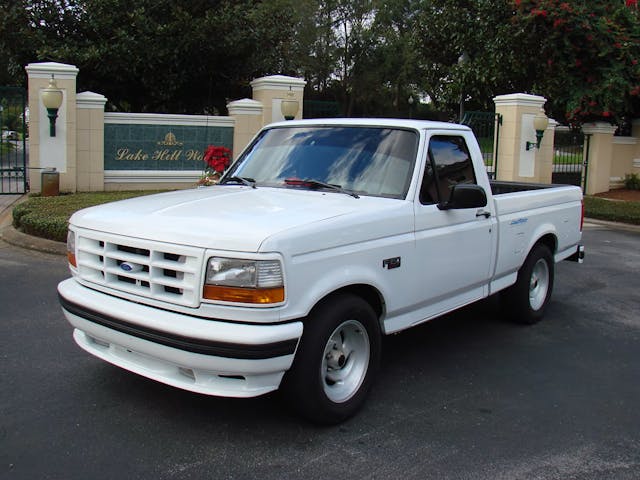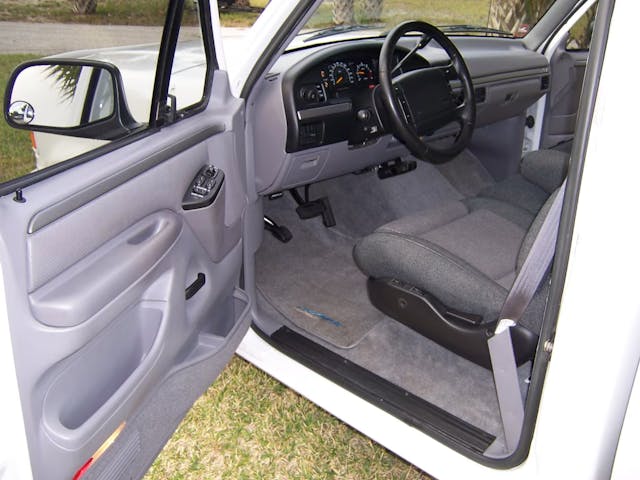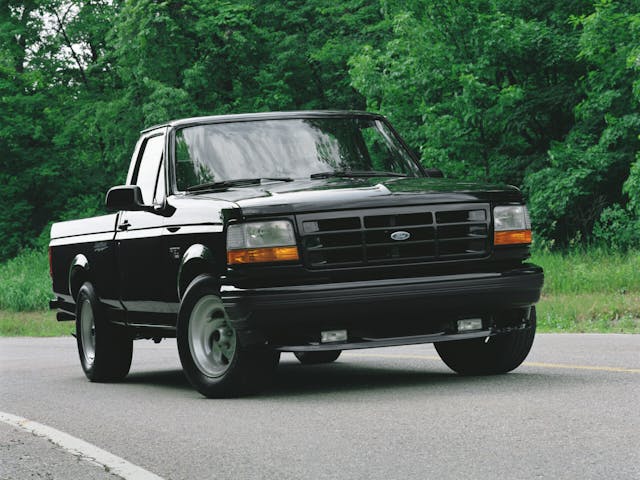Ford’s First-Gen F-150 Lightning Has Taken Off as a Modern Collector Truck
New truck shoppers know the Ford F-150 Lightning as the electrified version of the venerable F-150. Enthusiasts might think of the model a little differently, and remember the thunder of a V-8 backing up the name. As the hot-rodded version of the F-Series that debuted in 1993 as Ford’s entry into the on-again, off-again full-size muscle truck segment, the ‘93-95 Lightning has spiked in value as it rides a wave of interest among collectors.

Unlike with their segment-creating Mustang, Ford wasn’t the first mover when it came to fast trucks. Dodge lays claim to that title, having installed the 426-cubic inch Wedge engine into a very limited run of its D-Series pickups from 1964-66. They returned to the theme in the late ’70s, this time going all-out with stickers, exhaust stacks, and a big V-8. The 360-powered ’78-79 Lil Red Express made a splash as one of the quickest and most ostentatious vehicles on the market, only to disappear as quickly as it arrived.
A decade later, Chevy decided to capture the full-size muscle pickup segment with the 1990 454SS. Available in black or red, the bowtie pickup had the sandbox to itself for a couple years till Ford decided there was enough of a market for a little healthy competition, and debuted a powerful truck of its own.

While Chevy went with the basic approach of dropping a big block in the lightest possible configuration, Ford decided to have its Special Vehicle Team tweak the 351-cubic inch engine with a bevy of go-fast bits. Most noticeable when you pop the hood is the specially tuned intake manifold, but SVT also added GT40 heads, a larger throttle body, a more aggressive camshaft, and revised exhaust to maximize airflow. This resulted in 240 horses and 340 lb-ft of torque, 40 more in both measurements than the base 351. Putting power to the ground is a recalibrated four-speed automatic, aluminum driveshaft, and limited-slip differential.
Inside, adjustable high-backed bucket seats embroidered with “Lightning” set the interior apart from the average F-150. On the outside, the Lightning is clearly not your average early ’90s work truck, but it’s also not nearly as overt as Dodge’s Lil Red Express. Lightning graphics on the bed, 17-inch alloy wheels, color-matched grille and bumpers, and a front spoiler all suggest this is a sport(ier) pickup, but the look isn’t over the top.

No one will mistake a stock Lightning for an autocross champ, but SVT did make some handling improvements, too: lowering springs, improved dampers, bigger sway bars, and sticky tires completed the package.
The result is a truck with plenty of personality, if not outright performance. These first-gen Lightnings are a far cry from the brawn and capability of their 700-horse F-150 Raptor R descendants, and that’s ok. Sometimes a good-looking truck with clean lines, a decent-sized bed, and a nice, throaty burble is enough, and based on the Lightning’s valuation data, it seems that plenty of enthusiasts agree.
Like much of the rest of the collector market, these trucks began to appreciate in 2021. Where they differ from many popular models is that their prices continued to surge through the end of 2022 (after the market’s peak), and then, as the rest of the market began to taper, the Lightning has held steady. This generally tracks with the pickup segment as a whole, which has posted only minor losses compared to significant drops in more mainstream segments like sports cars and the once-white-hot collector SUV segment.
Also similar to broader market behavior, the cleanest examples have surged in value more than driver-quality vehicles, and the value delta between conditions has been magnified. That said, the ones you wouldn’t be afraid to throw two-by-fours in the back of are still relatively attainable, with #3 (Good)-condition Lightnings around the $25k mark and solid drivers hovering around the $10,000 range.
The outlook appears steady for the Lightning’s future, as well. About 71 percent of buyers are from Gen X and younger generations, and that share has been the same the past three years. Millennial interest is particularly strong, representing a nearly 30-percent share of Lightning insurance quotes, outstripping their market share by seven percent. Quote volume was up a healthy 13 percent in 2023, too, indicating growing demand.
No, the first-gen Lightning won’t power your job site like the new one can. It does, however, offer a durable, usable, and attainable entry point into the collector pickup world.
***
Check out the Hagerty Media homepage so you don’t miss a single story, or better yet, bookmark it. To get our best stories delivered right to your inbox, subscribe to our newsletters.



There are few things more obnoxious than hearing the words “Millennial” and “Gen Z.”
Somehow, people born in the early 1980’s are lumped in with people born in the early 1990’s.
In no way shape or form are those two generations even remotely connected. But they’re somehow grouped together.
Say this with me. A person who was born in 1980 got their license in 1996. A person born in 1990 got theirs in 2006. Different worlds. Different planets. But they get lumped in together.
One group was born into the cold war. One never know a world with the Soviet Union. But again. They’re somehow still grouped together.
And for what it’s worth, Lightnings were never unpopular or cheap. They’ve always been collectible.
As you alluded to the appeal of the Lightning is that it’s not over the top. Some reasonable performance upgrades and few subtle appearance mods. Other than the dated alloys ( a style I never cared for ) and the ‘Johnny Lightning’ decals on the bed its a nice appearing truck and looks as though it was meant to be used as such when required. Where as the Shelby F-150 for instance…you get the feeling of you wanted to put a cooler in the bed the owner would worry you might break an emblem or leave a small scratch.
Great review of a great truck! Glad to see them start to get their due. The entire 9th gen Ford pickups, aka “OBS”, with their heritage OHV V-8s, seems to be getting much more attention these days as a landmark design. Popular then and now, the 92-96 Ford F series is a practical classic which offers visual appeal along with some minor utility value as well. The seldom-seen Lightning version is just icing on the cake.
I have a friend with one of these. It’s a good truck.
Maybe the 1989 Shelby Dakota should have been mentioned in the comparisons? It’s a blast to drive and dependable, which is the reason it’s hard to find a low mileage example. I’m a Ford guy but love my Shelby Dakota.
Shouldn’t really be a surprise. If you want a good-quality truck with some character and analog engagement, but don’t want to pay a fortune for a new rig, why not get one of these? Sure, the mpg might be lower, but 1) you’ll more than make up for it in purchase savings, and 2) it’s a truck, who cares? These make perfect sense as fair-weather usable trucks. Hell, I’d get one if there were any in my area.
Donny D. – Your response is exactly the opposite of what I’d expect. While Hagerty groups certain generations together as a convenient way to measure the market it ignores (sorry guys ) the tweens, between this age and that. When I got out of high school I grabbed a job, worked a couple of years to bang some money in the bank then quit to go back to school and found another job to pay the expenses. By the time I got to a four year I was already older than those just entering. But those few years, though advantageous in some ways, didn’t seem to matter and I was exposed to the same experiences as those somewhat younger. The lines blurred until the point where there was no real difference. It was only when I went back home to ‘ small town usa’ when I noticed that the people I’d known there hadn’t changed much at all if at all. They were, simply put, less current and a bit stuck in a rut. It was only at a party when an old friend said – ” You’ve changed” and I responded – “I thought… that’s what you’re supposed to do right? ” – that I really saw a clear cut line. But that cuts both ways. I’ll listen to, and enjoy, Mel Torme ‘the velvet fog’ for example, but that was way before my time. Just like I wasn’t around when they were producing flatheads but I can appreciate one. Generational stats only serve as general data points no more.